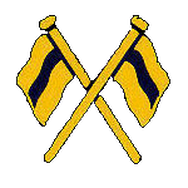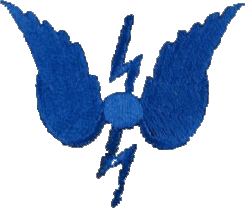|
|
|
|
This is a US Navy military tube type rack mount FSK converter adopted for use by the RN for the reception of the on-line broadcast utilising a BID 580. The audio center frequencies of 1,000 (narrow shift) and 2,550 Hz (wide shift) are supported. The shift range can be anywhere from 10 Hz to 200 Hz for the narrow shift and 200 to 1,000 Hz for wide shift. This converter was obtained from the RAF Henlow museum on its closure and has been refurbished in house. |
 |
|
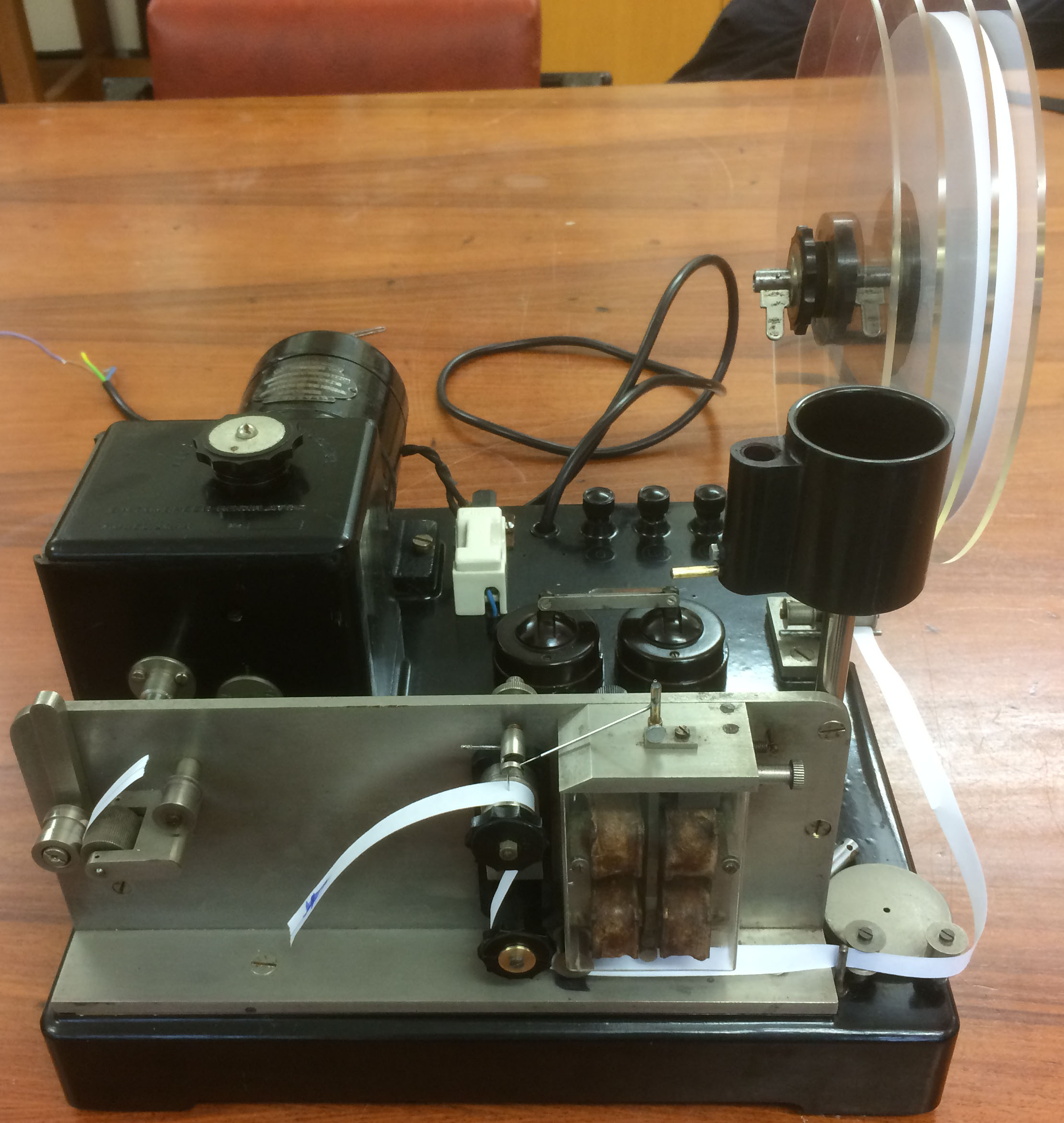 |
In February 2023 the Royal Signals Museum, Blandford kindly donated a Great Northern Telegraph (GNT) Company Undulator Model 309, This model was designed by GNT circa mid 1870s (this undulator is believed to have been manufactured circa 1920s) and was used to receive high speed Morse via radio and telegraph lines. See Undulator GNT 309 |
|
The museum acquired via a generous donation, twelve M11 amplifiers, three A11 tuners, and some parts of three K5 heterodynes from a house in Fetcham. They had been stored in damp conditions for decades and all had been partly dismantled. Some parts were missing from all of the sets. It was decided that the best approach was to make up a working A11 and M11 from the wreckage available. See Outfit CJ |
 |
|
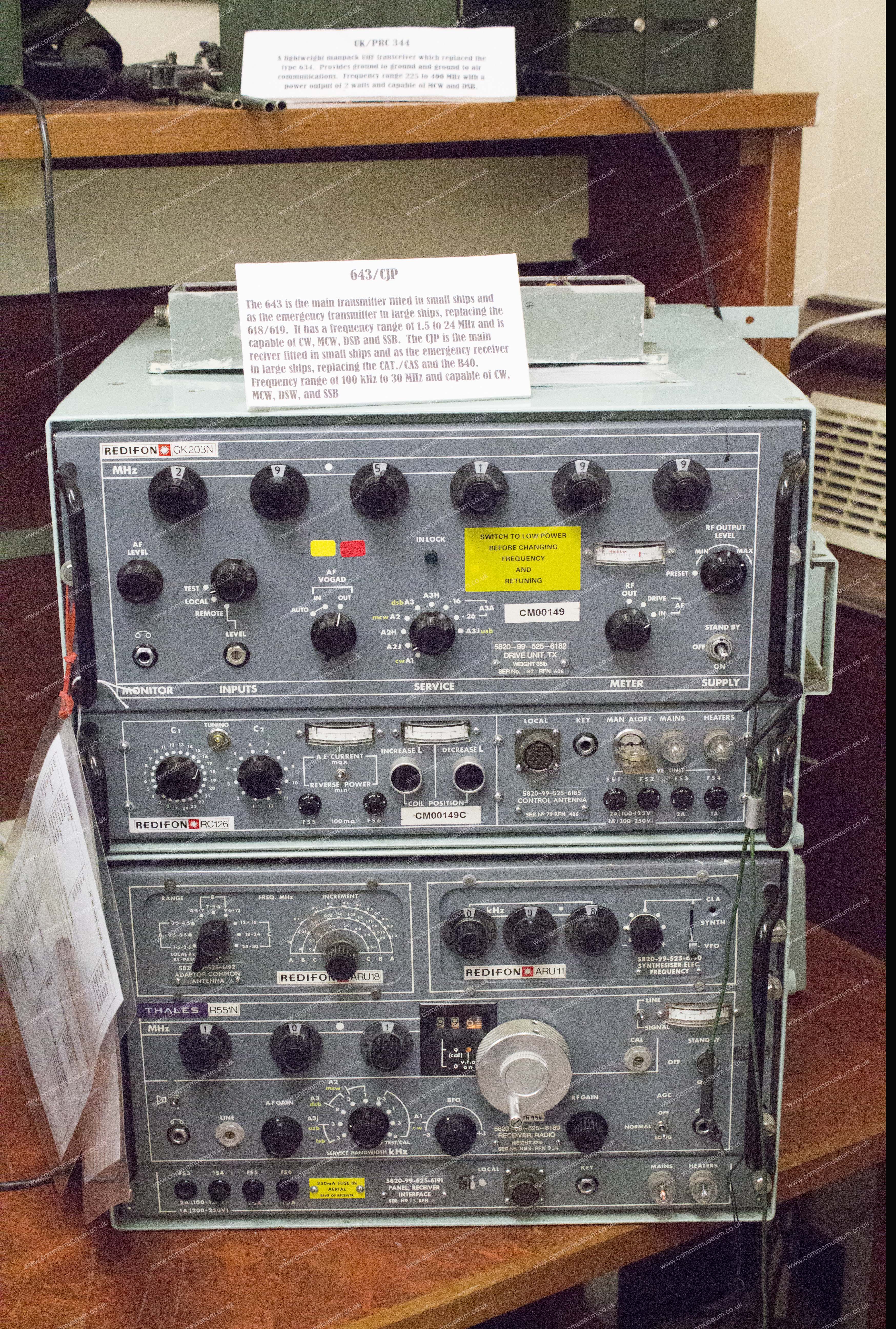 |
This 643/CJP was donated by Kettering Sea Cadet Unit and required a great deal of work to bring it back to life, especially on the wiring loom. Although reception is not great (lack of a proper tunable aerial) it is ideal for picking up the off-line 50 Baud RATT on 4, 7 and 10 MHz from DWD Weather Station, Germany for feeding the terminal equipment (TTT or TTVF(B)) and subsequent teleprinter. |
|
Eight of the 10 TGN Teleprinters were donated by Mick Rose of HMS Collingwood. These 8 had been used at some time in the past for maintenance training. All had faults of some form or other and it was necessary to cannabilise some machines to get others working. A further two machines were rescued from the MCO of HMS Bristol. A total of 6 machines were set to work, 3 of which can be seen in the museum, 1 is kept for spares, 1 transferred to the W/T Office of HMS Ocelot (Chatham Dockyard) and one to Sean Williams of The Communications & Electronics Museum Trust as a thank you for their donation of the Creed 444 teleprinter and a B40D receiver.
|
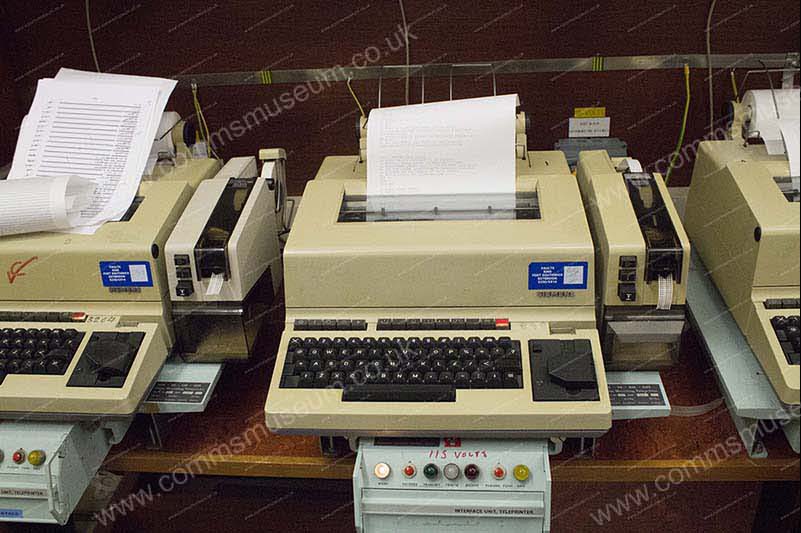 |
|
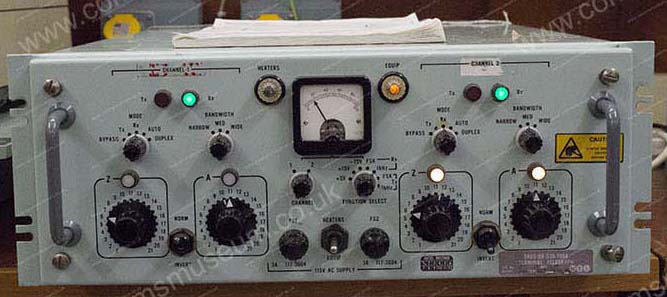 |
The TTT (Terminal Tactical Telegraph) is used in the museum to convert the two audio RATT tones from the reciever (currently either a CJP, B40D or a CLANSMAN 320) and converts them to 1kHz on/off tone, which is then passed to the teleprinter interface unit where it is converted to +80V DC when on and -80V when zero tone, passing them to the teleprinter (TGN) for printing. For transmission the opposite occurs. Although the TTT works reasonably well it does at times emit sufficient interference to blot out the reception of the RATT signal. If this happens then we revert to using the TTVF(B).
|
|
The B40C was introduced in 1948 as a replacement to the B28. The main differences between the C and the D versions are that the C has no Oscillator Trimmer and no FSK facility. This set was donated by Robin Wickenhden and required the replacement of the AF Control Resistor, a new power socket and replacement of a couple of IF Amplifier valves. With some re-aligning this set is now working. Sat on top of the B40C is a Receiver Adaptor Outfit FAZ which was designed to adapt the B40C and the B41 receivers for single side band operation for attended or nominally unattended reception of Wide Shift RATT (850 Hz shift) and Narrow Shift RATT (85 Hz shift) and Single Sideband Voice. Some further work is still required on the FAZ to increase the AF output. |
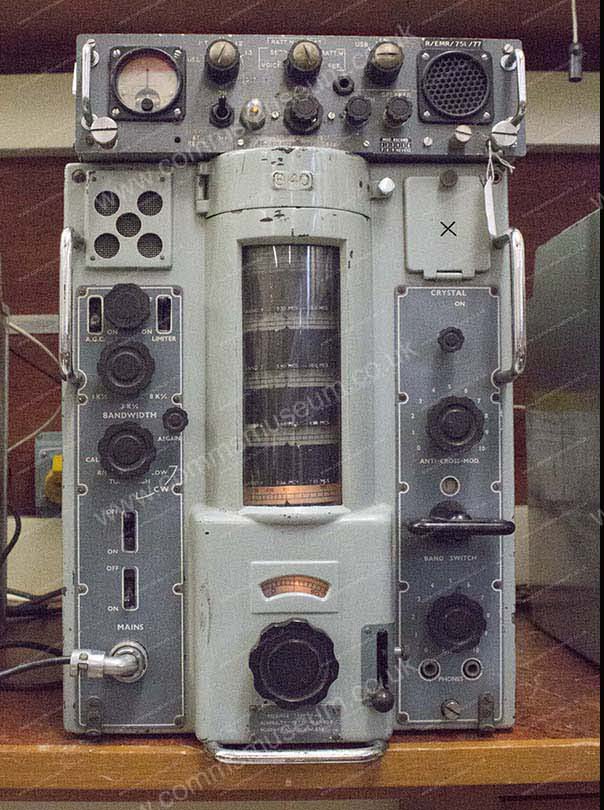 |
|
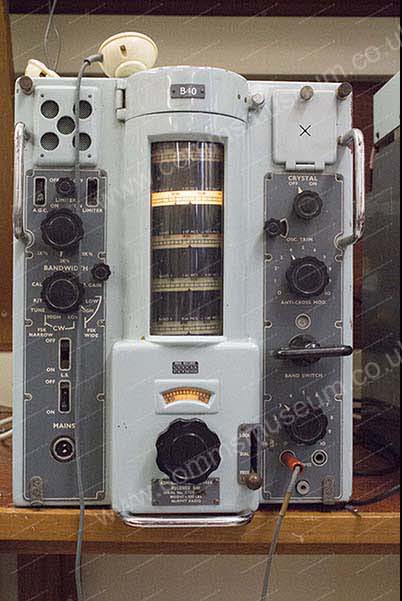 |
This B40D set was donated by Bill Morris of Beaconsfield. It belonged to his late father Ken Morris and had been kept in a loft space for over 30 years. In the main the receiver was in a reasonable condition and only required a re-alignment of the turret frequency selector, some tweaking to the AF valves, and a clean out of cobwebs and dust (somewhere in the museum are a couple of rather large spiders , that legged it once the outer case was removed) but the set is now fully working. The B40D was introduced in 1946 as a replacement to the B28. Its frequency ranges is 650 kc/s to 30 Mc/s. In its current aerial configuration it is known as Outfit CDW but when configured for Common Aerial Working is known as Outfit CAY. It is currently used to demonstrate the reception of RATT via the TTT or TTVF(B).
|
|
The B41 was donated by Les Langrdige. Sadly the set was in a very poort state of repair with the RF Unit 4 ganged capacitor spindle broken in half and several valves not working. Thanks to the staff of the CHC it was possible to manufacture a new spindle and with the provision of a couple of new valves the equipment now works. However, it still requires a complete RF/IF alignment which has for the time being been put on the back burner due to the amount of time required to carry this out. Its frequency range is 15 kc/s to 700 kc/s and it its current configuration is known as Outfit CDY but when configured for Common Aerial Working is known as Outfit CAZ. |
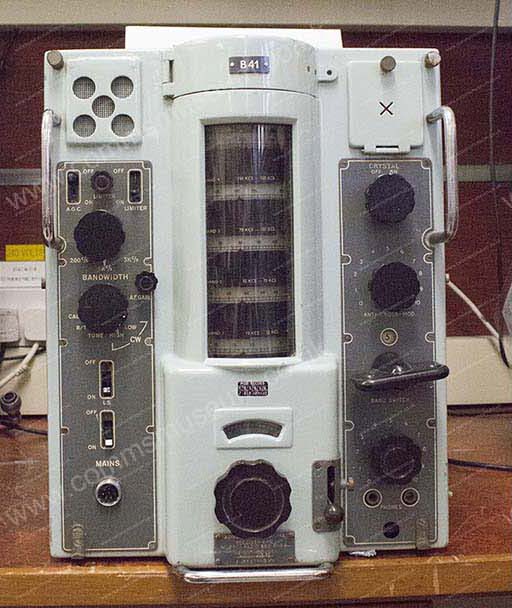 |
|
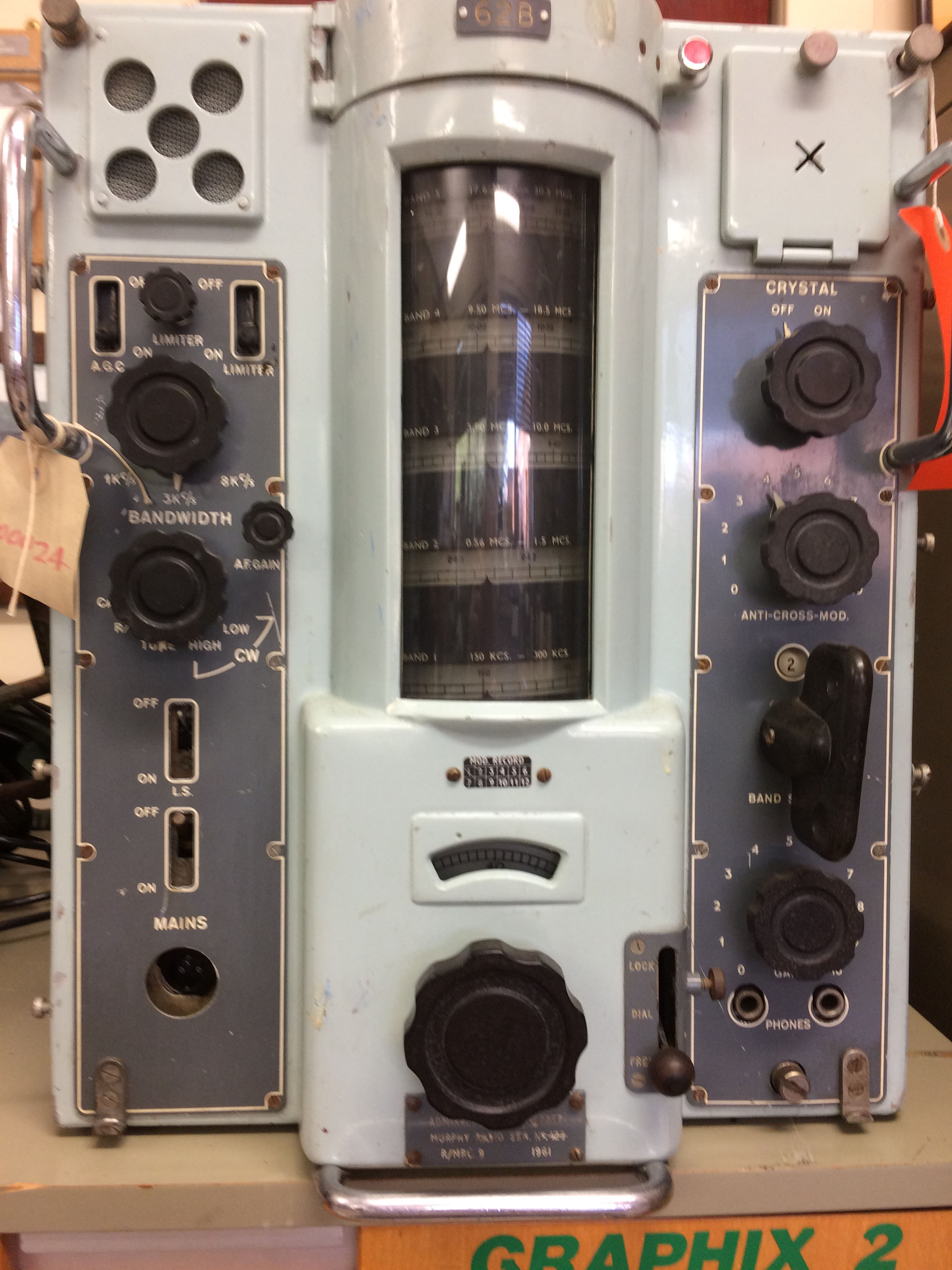 |
This 62B was rescued from the workshops of the now closed Collingwood Heritage Collection. It is a general purpose LF-HF communications receiver built for the Admiralty by Murphy radio Co. It looks and functions in a similar manor to a B40 described above. It is capable of receiving CW, AM and FSK. Works on 115 or 240 VAC. Uses 15 valve, single conversion super-heterodyne, Frequency range - 150-300KHz, 0.56-1.5MHz, 3.9-10MHz, 9.5-18.5MHz, 17.6-30.5MHz. It was primarily fitted in RN ships SRE compartments in order to provide entertainment (music, news etc) which was then fed through the ships main broadcast system. It is hoped that in the next few months to give the set a complete overhaul and return it to good working order. |
|
The filter on the left is a band stop filter fitted into outfit EZ. The purpose of this filter was to ensure that when a transmitter and its associated receiver were operating on different frequencies (duplex) then the transmitter is switched to key in and out the filter during transmission. The filter is situated in the aerial line going to the receiver. On the right is a 1275 Hz filter fitter in a TTVF(T). |
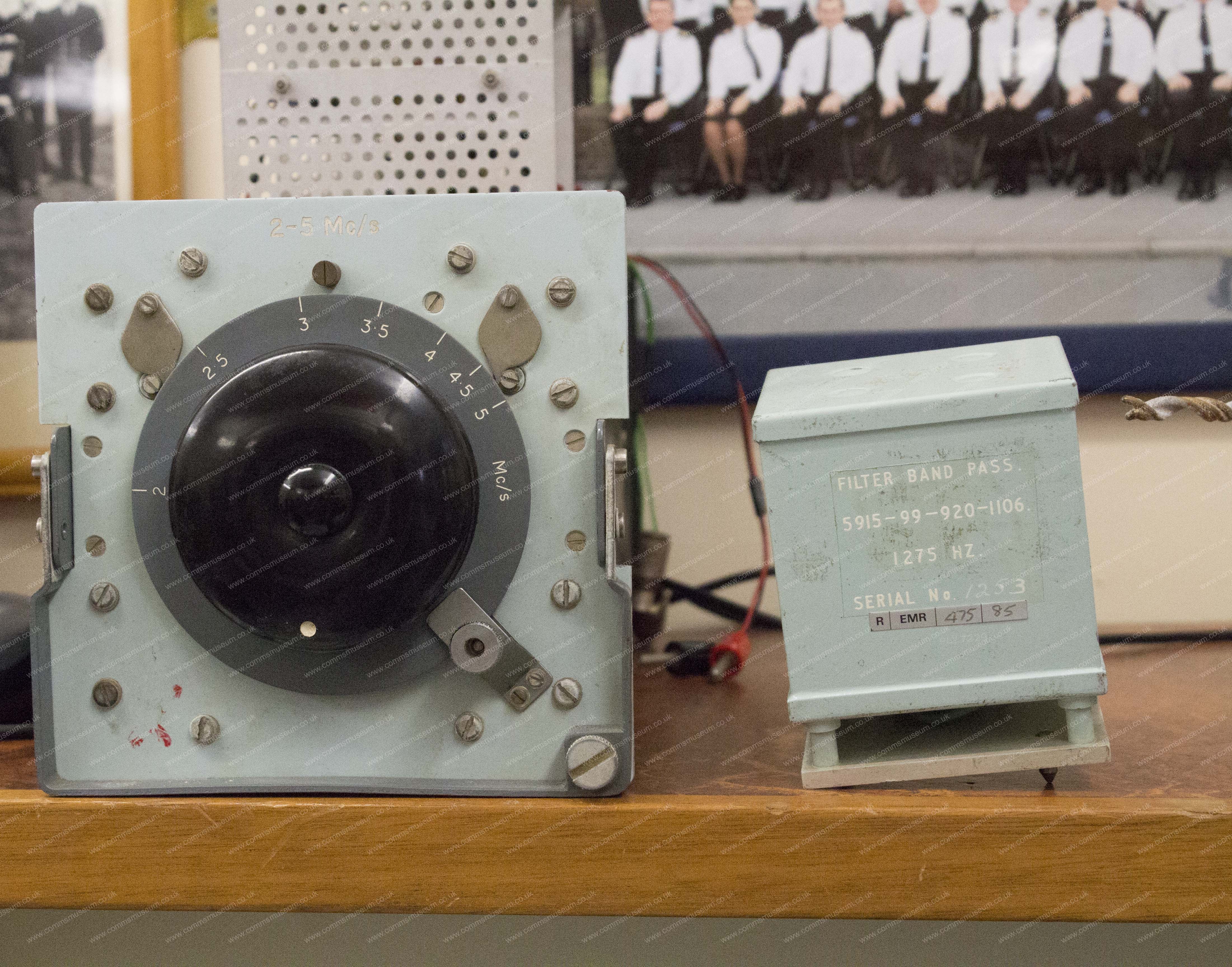 |
|
 |
This UKPRC 320 is a British built, solid state HF radio of the Clansman series. Developed and built by Plessey Enterprise. It was manufactured in 3 versions, two of which were capable of LSB or LSB/USB. This set is capable of USB, AM and CW. Introduced into the RN circa mid 1970s and was replaced by BOWMAN circa 2010. With the purchase of new batteries this set is in full working order and has been used to receive a RATT signal and by tapping the audio output from the headphones and feeding it to the TTVF(B) we have managed to print the RATT on the TGN. |
|
This UKPRC 344 is a British built, light weight solid state UHF/AM Transceiver operating in the frequency range of 225 to 399.9 MHz band with 50 kHz channel spacing giving a total of 3500 synthesized channels. Channel selection is by three decade rotary switches and also has controls for mode selection and volume level. With the purchase of new batteries this set is in full working order.
| 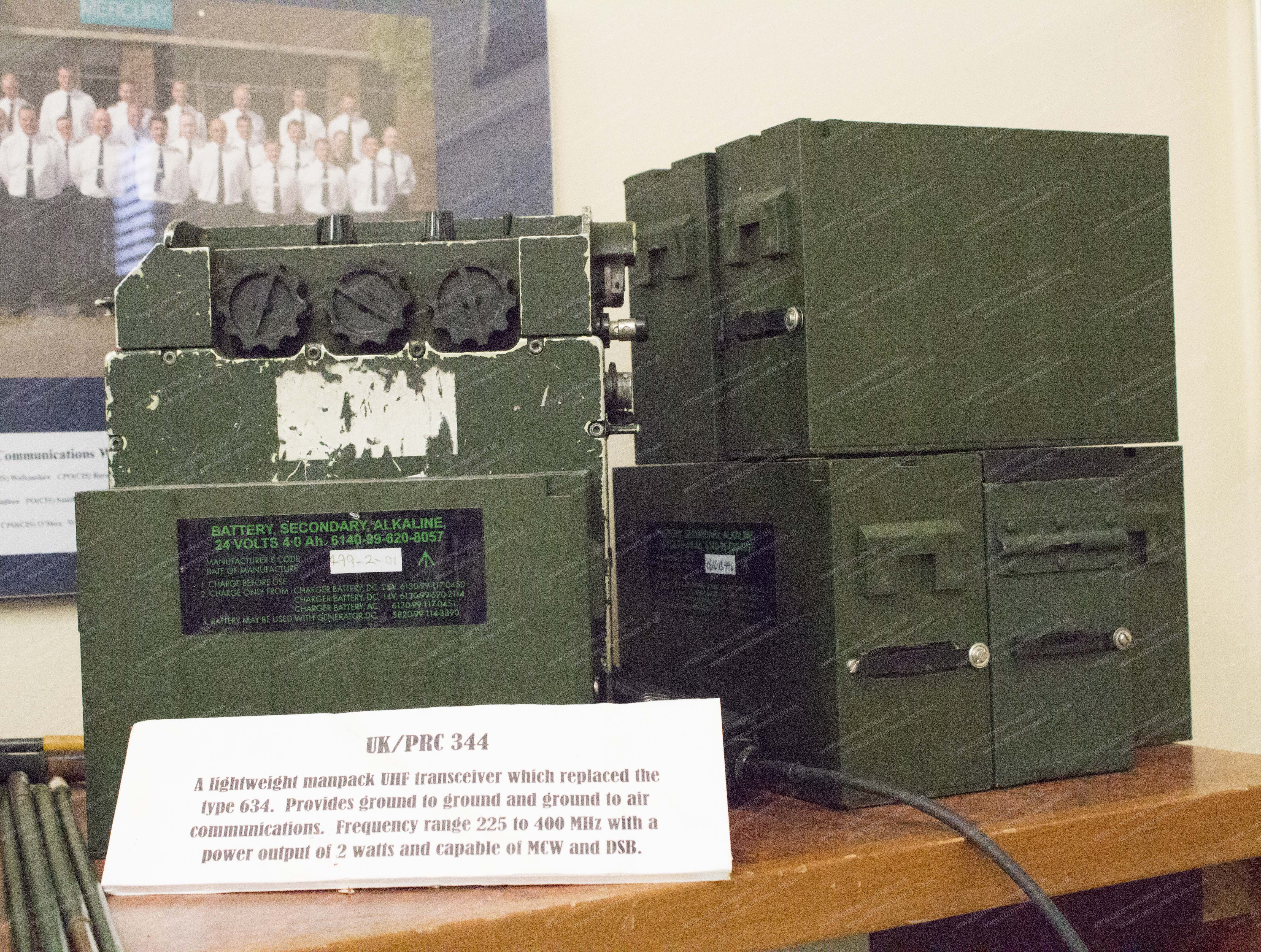 |
|
 |
The IBM Laptop was considered to be a top of the range laptop in 1992. It ran on an i486/33 MHz processor with 4MB of RAM. The display is monochrome with a maximum resolution of 640 by 480 pixels. It is fitted with a 3.5 inch floppy disk drive but no USB port. Its main software was Toshiba DOS 6.2 and Windows 3.1. Donated by Ian Stirton-Smith and although the laptop is in full working order it runs at the speed of a striking slug!!! |
|
The Creed Type 75 Teleprinter was developed circa 1958 and introduced into the RN in the early 1960s. Capable of 50 and 75 baud speeds and a a later stage 100 bauds. This machine was recovered from the typing trainer classroom but has some major faults. Sadly a good TP Maintainer of old is no longer available and at the moment it is beyond our capability to get this running again but we have not given up on it - yet! |
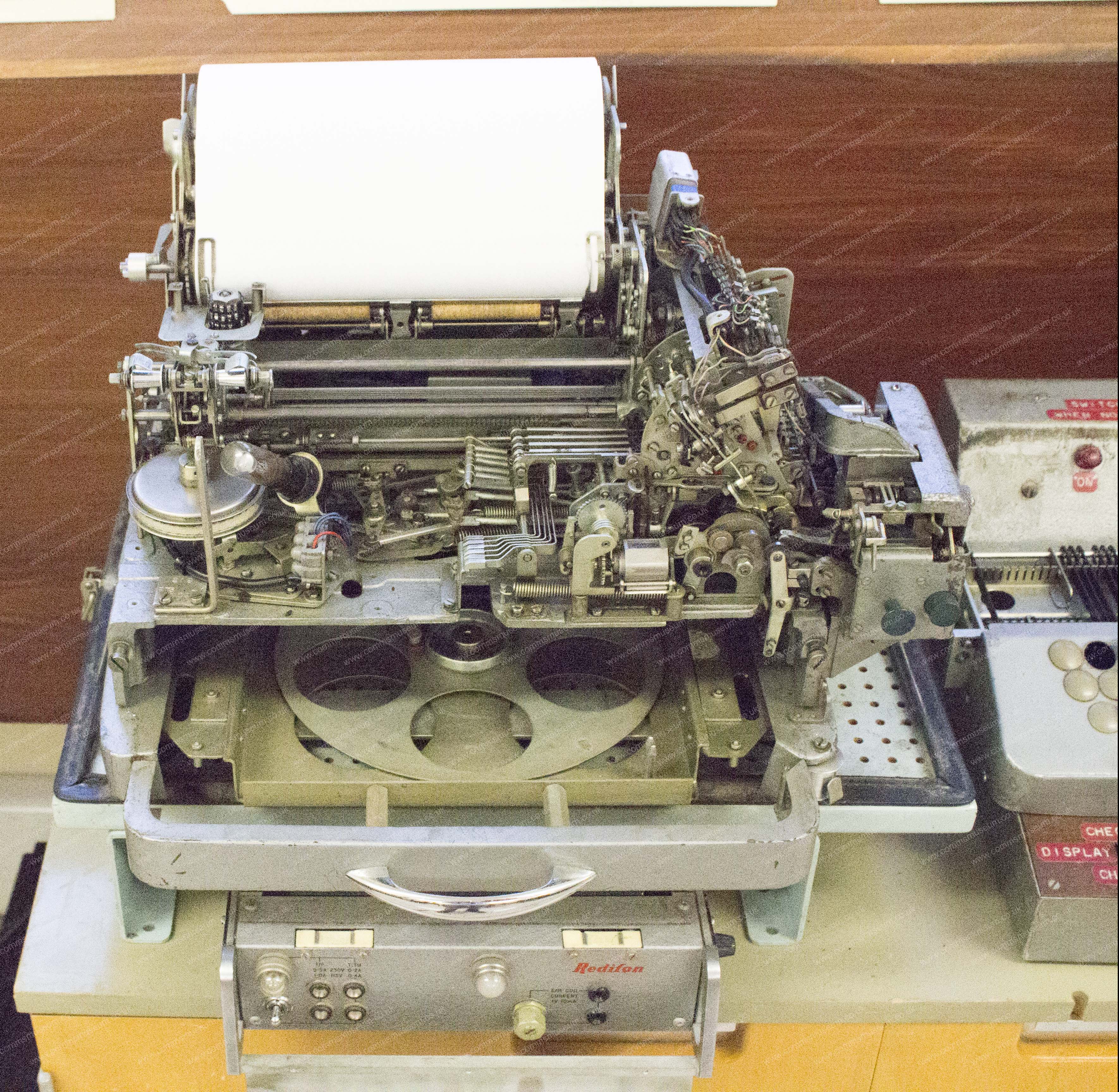 |
|
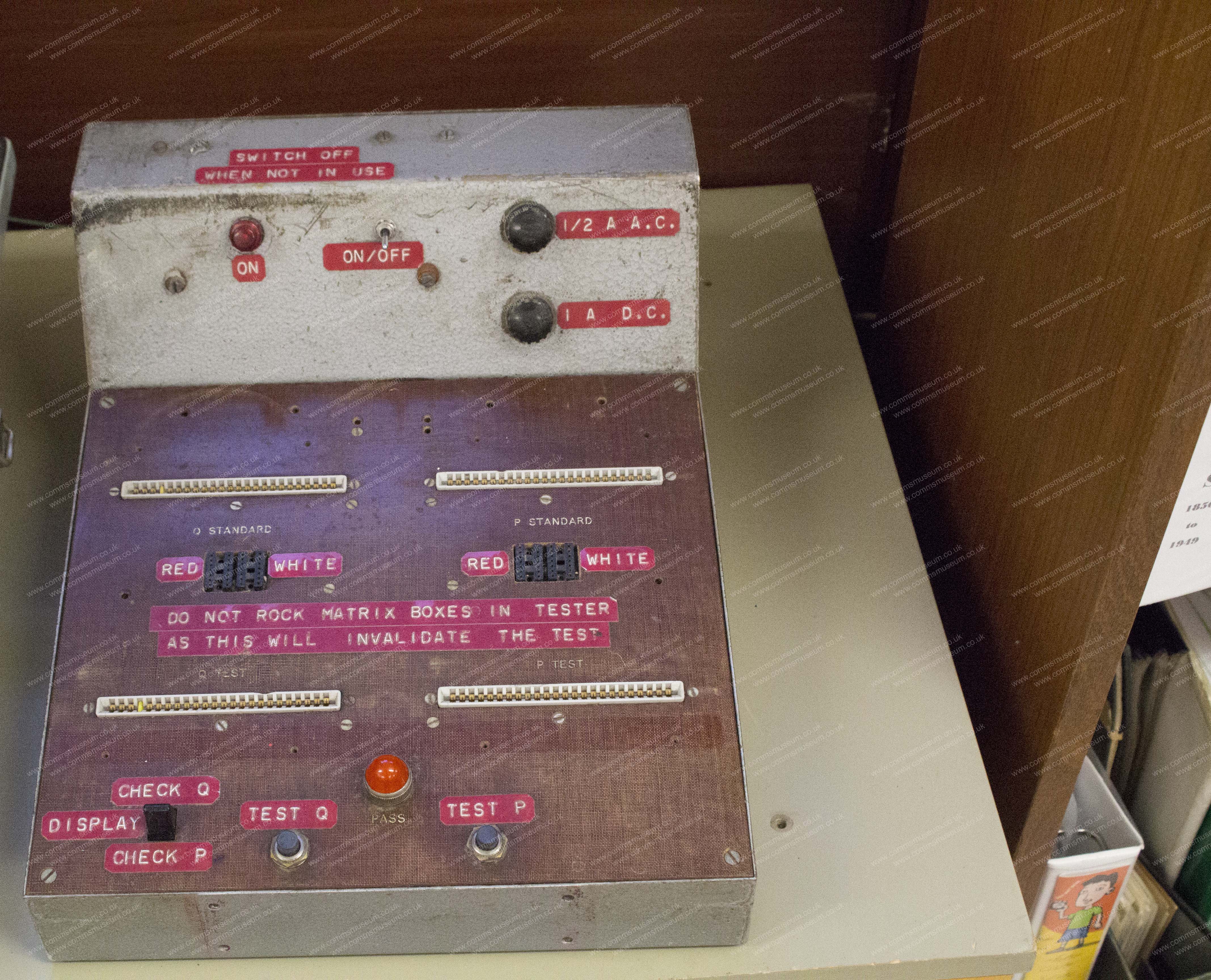 |
For all those that remember those many night watches making up the BID boxes for the next day, this piece of kit was a god send. Two pairs of boxes could be placed into the slots - the Test button is then pressed and if the test light lit then the boxes were made up correctly. This piece of kit originally came from Commcen Fort Southwick. |
|
NAVTEX is an international automated direct printing service for promulgation of navigational and meteorological warnings and other urgent information to ships. NAVTEX broadcasts are primarily made on the 518 kHz (International frequency and always in English) and 490 kHz (primarily for broadcast in local languages). This set was, until recently, used in the GMDSS training classroom and is fully operational. |
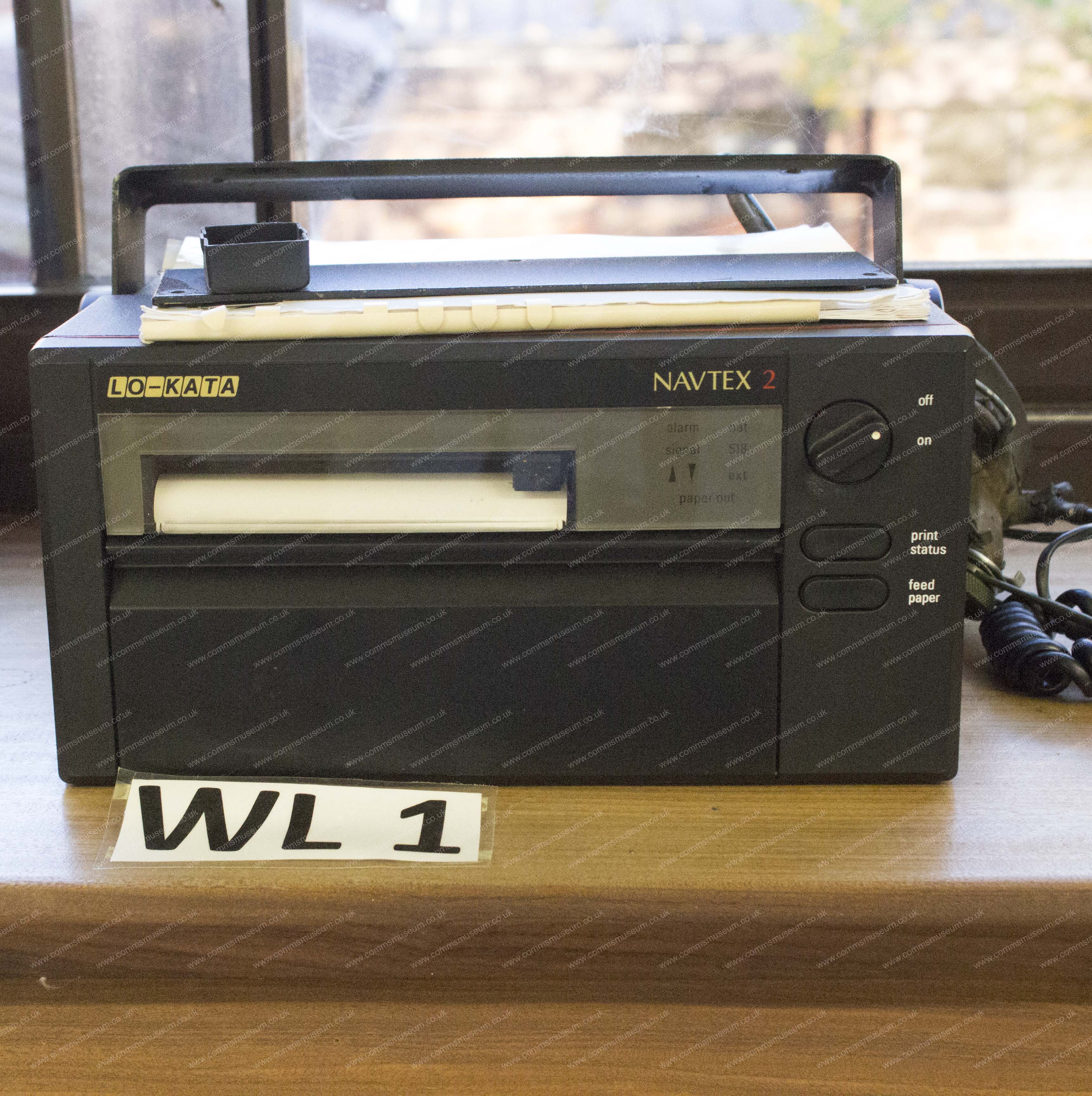 |
|
 |
The SURVIVOR II is a Liferaft Emergency Radio Set. Manufactured by Clifford and Snell and known as the Type 710 and re-branded as SURVIVOR II by Marconi. Transmits on 500 kHz, 2182 kHz and 8364 kHz and Receives on 500 kHz and 2182 kHz. Automatic keyhing facilities are included to transmit the 12 x 4 second dash alarm signal plus SOS. Ancillary equipment includes a steel telescopic aerial which extends from 20 inches to 15 feet. |
|
The Pye Reporter is a VHF set used by the Quartermaster at the Main Gate to talk to patrols. This set was donated to the museum by Ian Fuller and is still in good working order. |
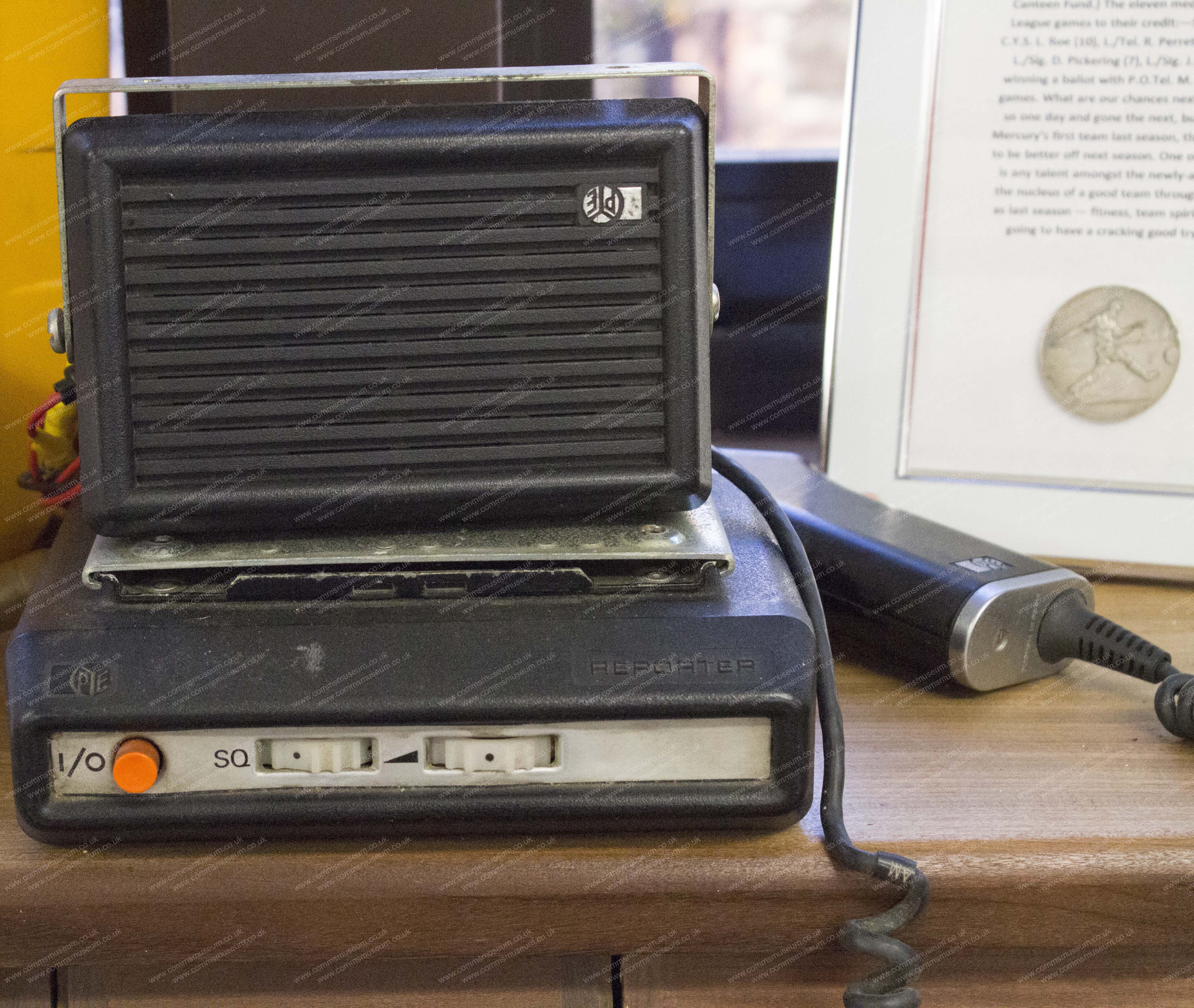 |
|
 |
The GNT 112 Morse Tape Transmitter was manufactured by the Great Northern Telegraph Company and is believed to be circa 1950s. It was originally fitted in one of the HMS Mercury Morse training classrooms and will transmit at speeds from 1 to 30 wpm. With no transmit facilities in the museum it was necessary to build a small relay to switch the output (+6v/0V) on and off and feed the the output to the Local Oscillator of the Audio Morse Trainer thus providing and audible output in order to demonstrate the GNT 112 capabilities. |
|
This is the Audio Morse Trainer that was originally fitted in one of the HMS Mercury Morse classrooms. For the teaching of morse reception it was configured to accept an input from a GNT112 Morse Tape Transmitter and deliver the audio output to 16 positions in the classroom. For transmission, each of the 16 positions in the classroom had its own morse key which fed into the Audio Morse Trainer which then delivered the audio output to the headphones at each of the 16 positions. It also has a local loudspeaker output which is now used to demonstrate the audio output of the GNT 112 or via a morse key. |
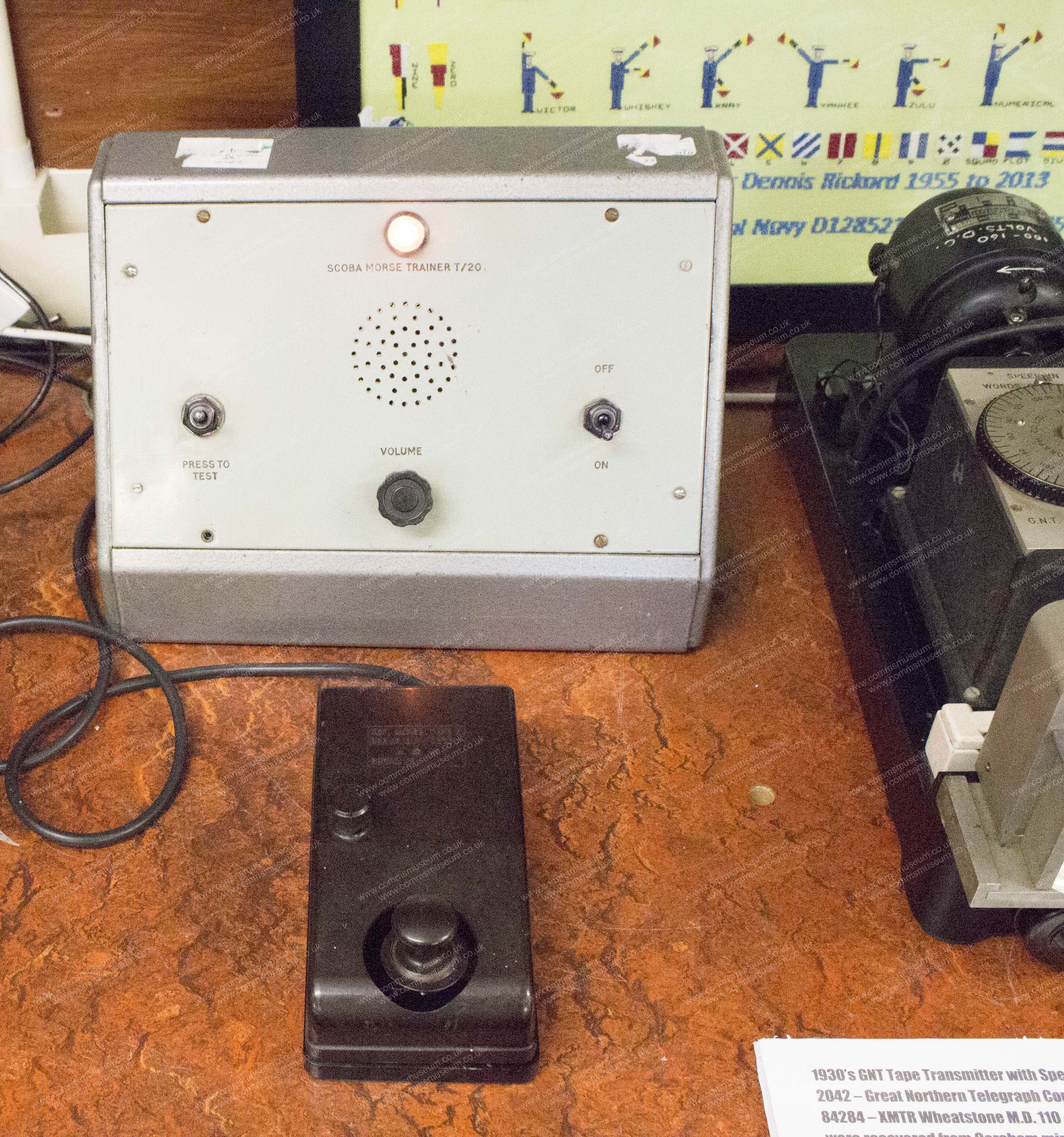 |
|
 |
This is the 1930s version of the GNT Tape Transmitter. This is a model 2042 fitted with a speed regulator that ranges from 1 to 240 wpm. It was manufacture by the Great Northern Telegraph Company with serial number 84284. Two of these machines were recovered from Corsham Mines, both of which were in a very dilapidated state suffering from severe rust and broken parts. After soaking the mechanical parts in a bath of diesel for a few days enough parts were recovered to construct one machine that is now fully operational. It is capable of reading morse tapes produced by the Creed Morse Tape Perforator. The downside was that the motor works from 160V which required the building of a voltage regulator to bring the 240V mains down to the required voltage. |
|
This is a circa 1930s GNT 451 Tape Re-generator. Manufactured by the Great Northern Telegraph Company Limited circa 1930s. This one was rescued from Corsham Mines and like the other equipment had a great deal of surface rust and some very brittle wiring. After a good deal of refurbishment including the replacement of the internal wiring the GNT 451 is fully working. Coupled with a GNT Relay Model 1/35 the machine can then be connected via telegraphic/phone lines to a distant GNT 112 Morse Tape Transmitter. The 451 will then re-produce the morse tape from the incoming Morse signal. We are still looking for the GNT Relay Model 1/35. |
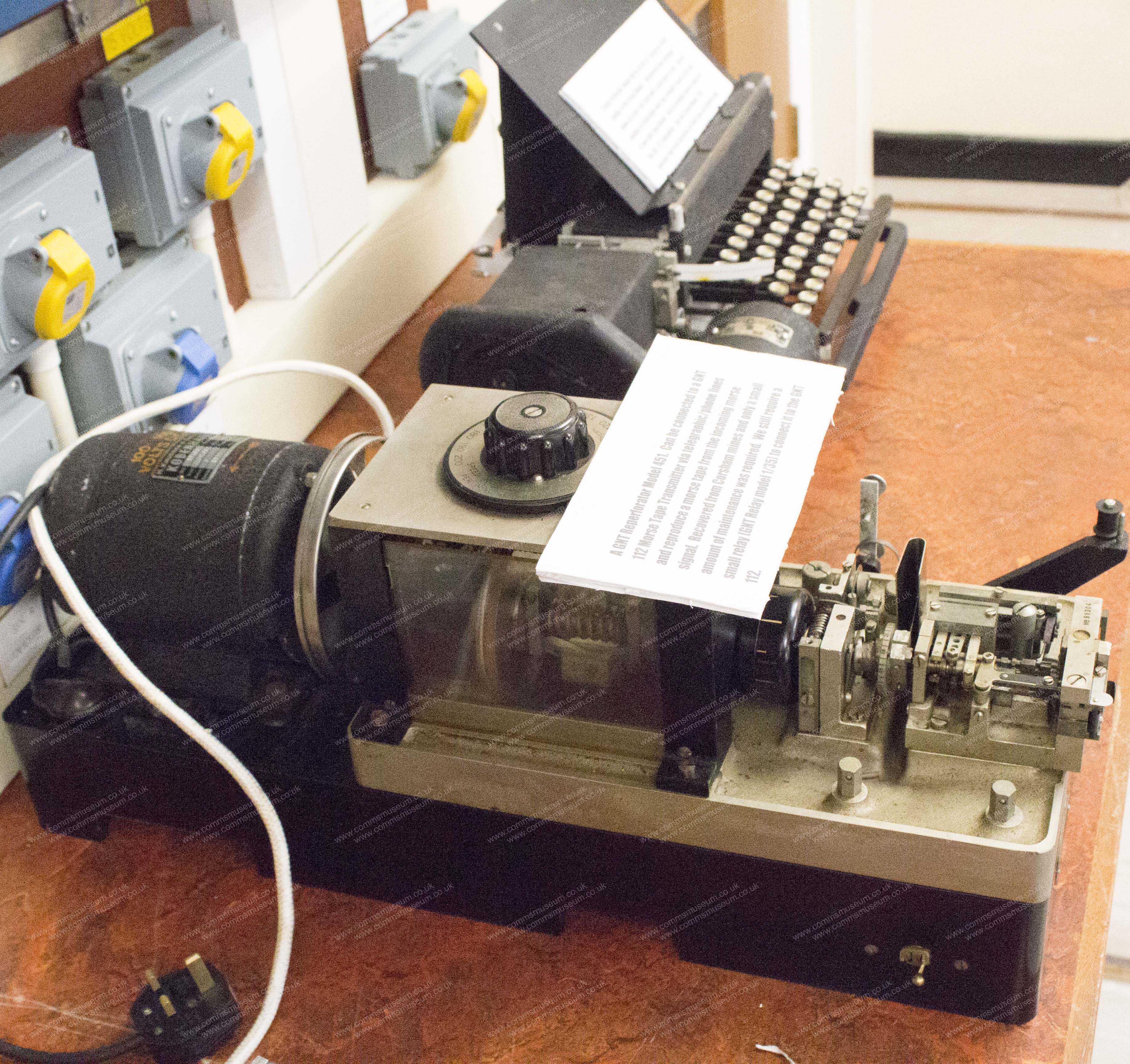 |
|
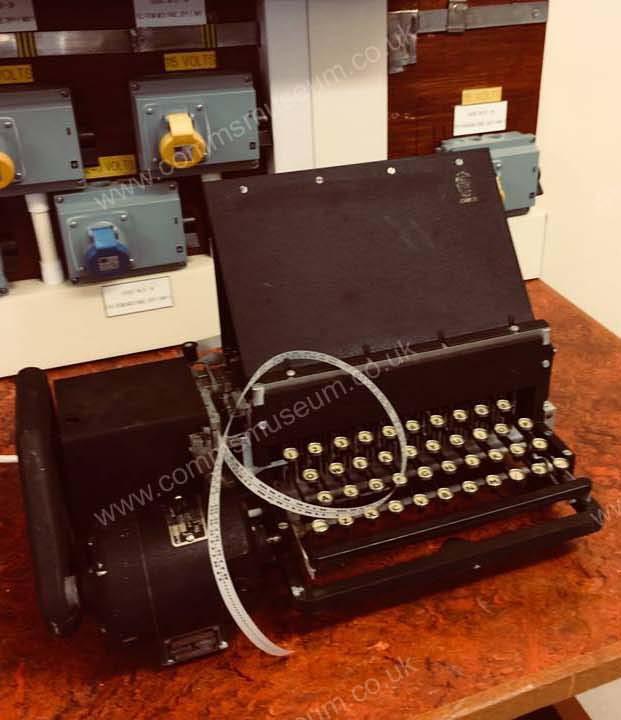 |
Another piece of vintage equipment also recovered from Corsham Mines. It is a Creed Morse Tape Perforator model 9W and was fitted in many Communication Centres until the mid 60s. As with the other equipment recovered from Corsham Mines it was in a very bad state of repair and required a complete strip down to remove all signs of rust as well as replacing all the brittle internal wiring. Four months of work finally saw this machine come back to life and it can now produce Morse tapes for the GNT 112. |
|
Purchased from eBay this typewriter was well known to those who underwent training between the 1950s to the 1970s. Although, mechanically it was in a reasonable condition it did require a complete strip down and a good clean to get rid of all the old oil, dirt, fluff and the odd dead spider before it would work properly. The major problem was the gearing for the ribbon reels but once taken apart, rebuilt and oiled everything was once again working. |
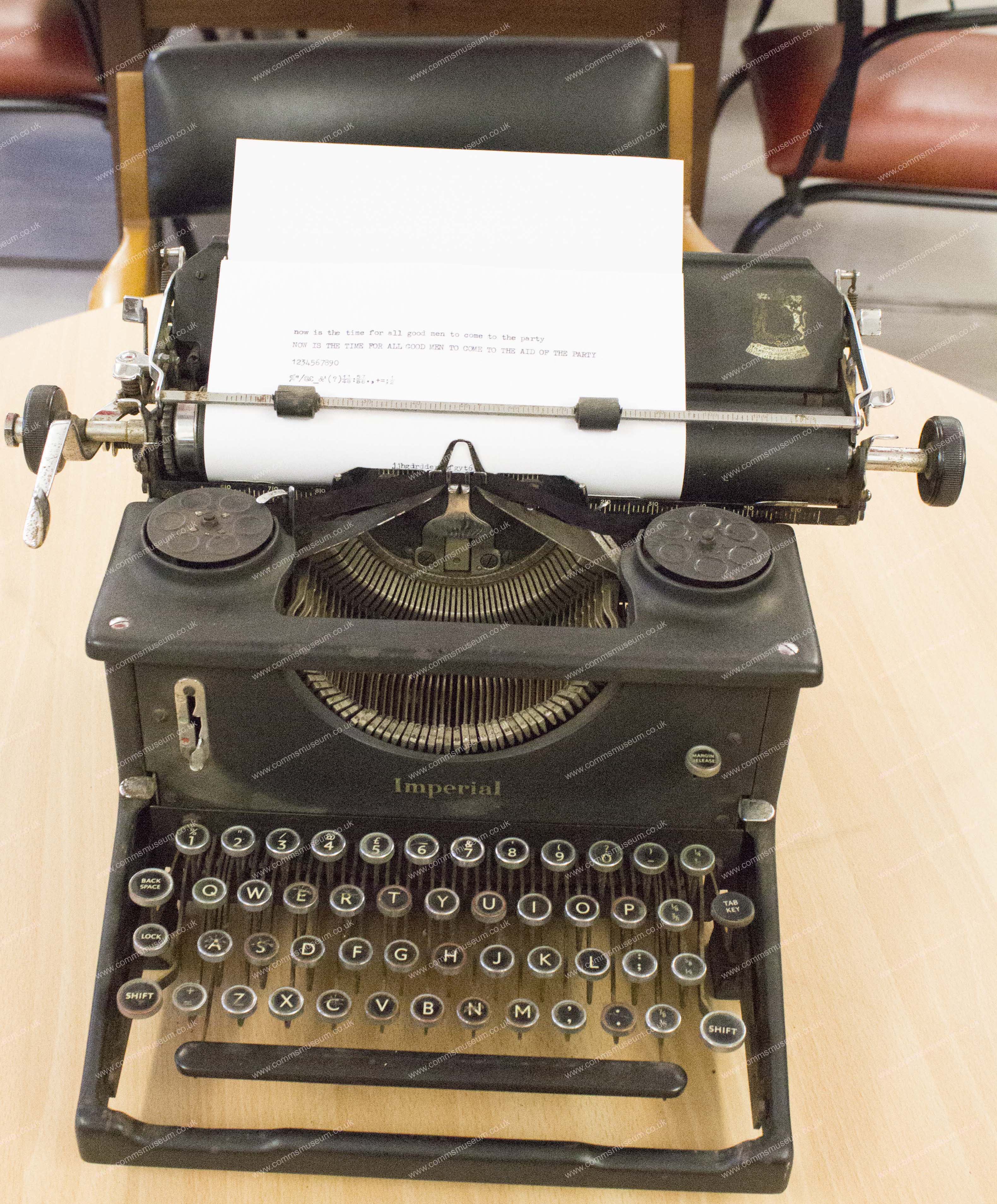 |
|
 |
Another piece of equipment rescued from Corsham Mines. We originally rescued two but both were in a very bad state (mainly rust) but we have managed to put one good one together using parts from both machines. This is a Model M (magnetically controlled clutch) and is believed to be an early version as it is only capable of 50 bauds (later models were capable of 50 or 75 bauds by means of a changeover switch). The 6S6 would have been connected to a Creed Type 12 or Tye 75 via a TT10 so a great deal of modifications were required to get it to work with a TGN. For those interested the following mods were undertaken: We modified the back panel to hold an IEC mains socket, a 4 way Jones socket, a 12-0-12v mains transformer and a voltage doubler power supply running off 24v from the transformer. This gave about 50v to run the 6S6M electromagnetic clutch. Inside the relay box we constructed a veroboard circuit containing a +/-6v power supply and a 1kHz keyed oscillator. The Mark and Space contacts in the 6S6M head were wired to the +/-6v so that the tongue produced 6-0-6 signalling which connects to the veroboard oscillator and a spare pin of the Jones socket (currently not used). The oscillator has a jumper that can be set to produce a tone for +6v or -6v from the tongue. Currently it is set to produce -6v on Mark and +6v on Space. The tone was then fed from the Jones plug to a 1/4 inch jack plug which is then plugged into the monitor socket on the teleprinter interface unit as this was the easiest way to connect them both rather than breaking into the 105 multiway connector used elsewhere in the system. The sound proof cover is still under refurbishment due to the amount of rust but once finished it will reduce the noise level of the 6S6 when working. |
|
This Creed 444 teleprinter, dontated by Sean Williams of The Communications and Electronics Museum Trust, was introduced in the early 1960s as a replacement for the Model 7 for Telex purposes and was fitted in most Commcens. We still need to build in some further electronics to get it fully working and to provide a +/- 80V power supply. |
 |
|
 |
The B28 was for many years, throughout WW2 and afterwards, the main Fleet MF/HF Receiver. Outwardly, its switches and controls were simple and uncluttered when compared with the B29, and it was a superhet receiver, as opposed to the TRF (Tuned Radio Frequency) of the B29. In most cases, a ship would have several B28's fitted to just the odd B29. It was known under the following names: CR100 was the manufacturers name, Tuner-Amplifier B28" its name when first entering service with the Navy, the CDC was its official sea-going name and CDL when fitted ashore in Naval W/T Stations. The B28 was replaced by the B40. This set was transferred from the now closed Collingwood Heritage Collection and is in full working order. |
|
The B19 Tuner/Amplifier was designed in 1937 and has a frequency range of 40 to 13,500 Kc/s. Originally designed as a receiver for the transportable set Type 52T, but has been modified and arranged for box mounting in Receiver Outfit CBA with battery supplies as a part of Type 60E, and for rack mounting in Receiver Outfits CBB with battery supplies as the standard emergency receiver equipment of its day. After a great deal of 'fettling' this receiver is now in full working order. |
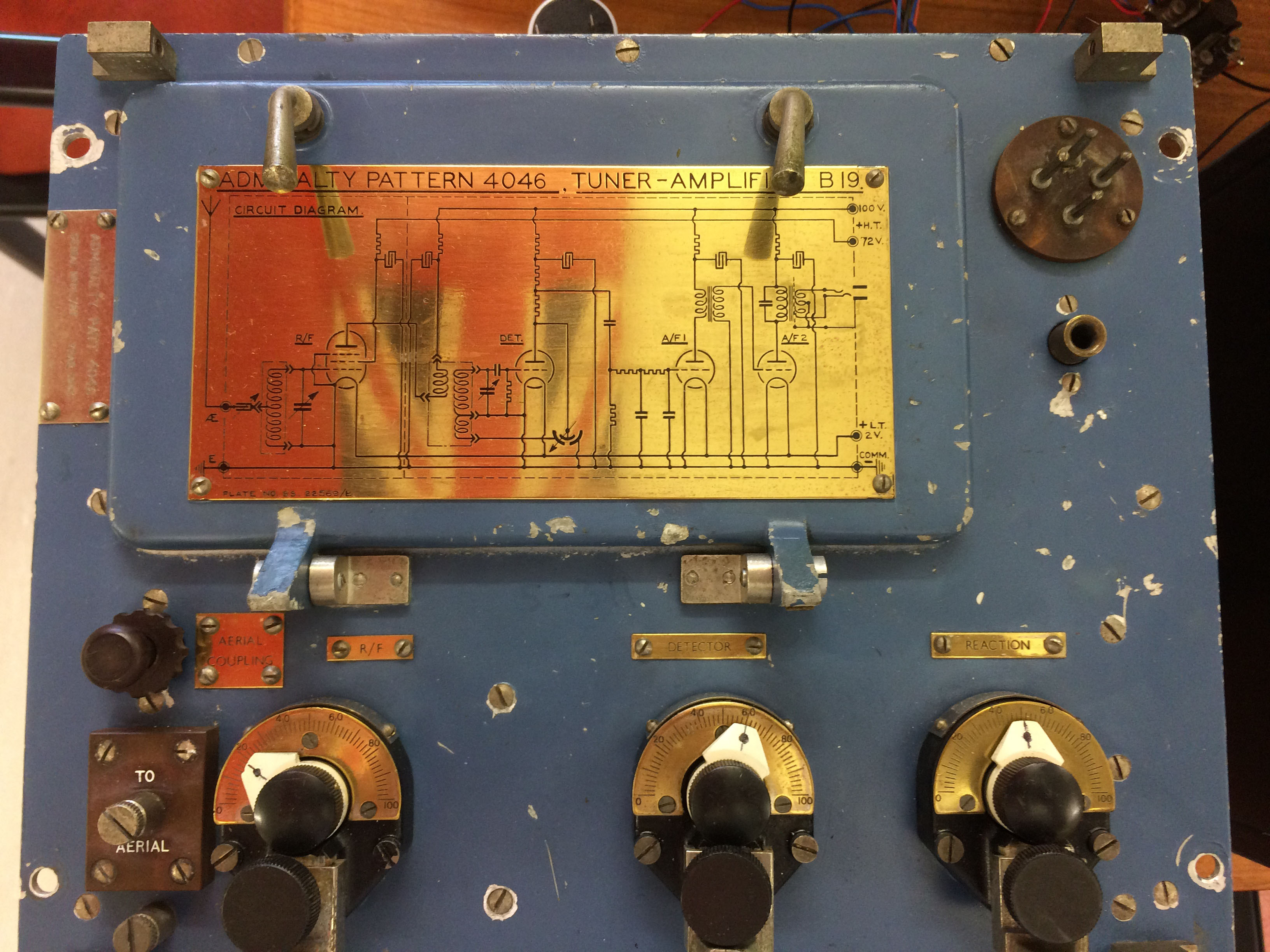 |
|
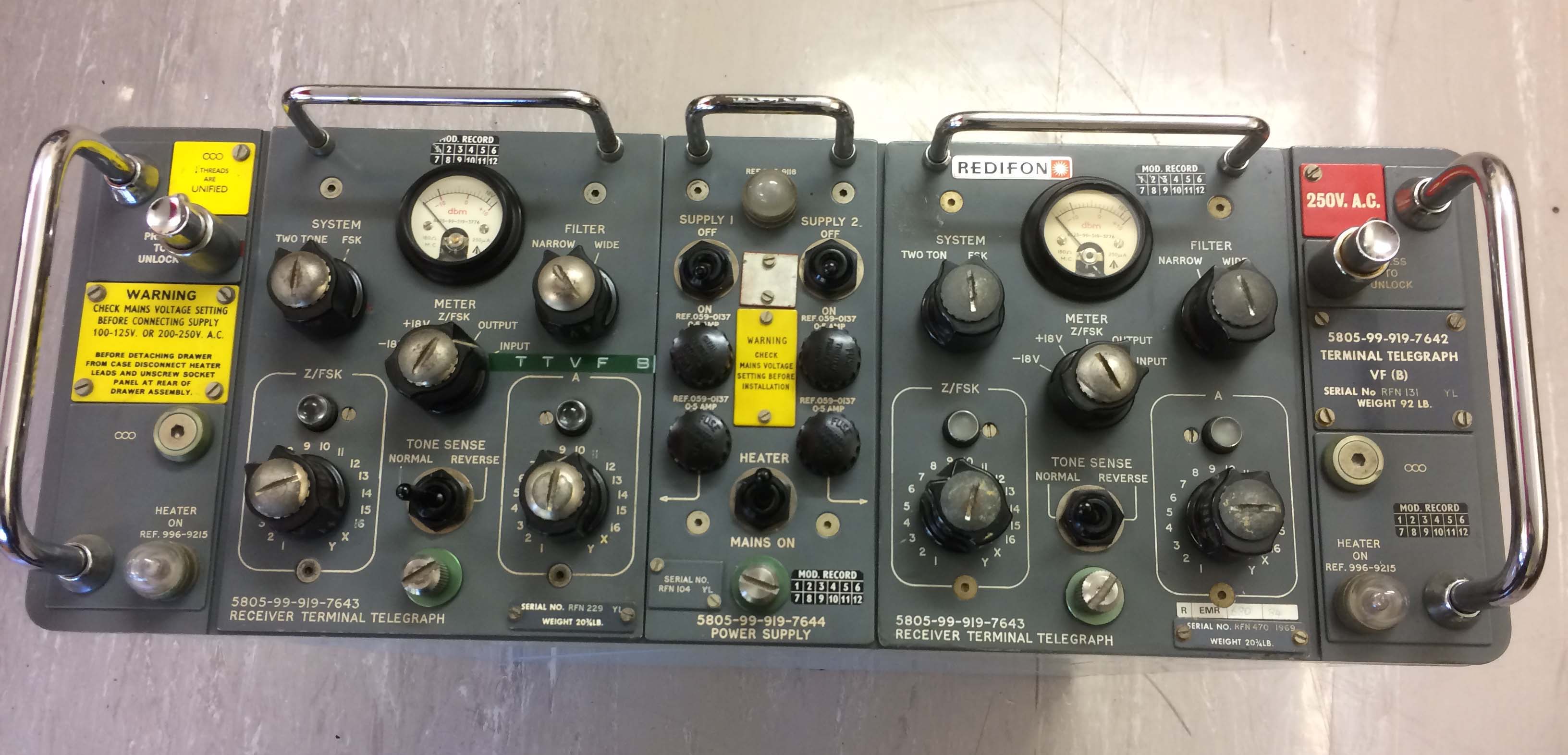 |
Terminal Telegraph Voice Frequency (Broadcast)- converts a recived teletype signal comprising a pair of consecutive tones to an on/off keyed 1kHz tone, which after further processing may be used to activate a teleprinter. It takes an input of any two tones used in FST or A2 Ratt working and outputs 1 kHz on/off keyed tone at a speed of upto 75 bauds. The TTVF(B) comprises of two TT20 receiver units and a common twin power supply. For demonstration purposes, at times when there is no suitabe RATT signal to print we connect the TTVF(T) directly to a laptop which generates the two tones and outputs a simulation of the B11A Broadcast. |
|
This is the SOLAS II Liferaft set. This image shows the bottom half of the box, the top half contains the ancillary equipment, e.g. the winding handles that provide power, the mast etc. The complete box is sealed and stamped on the top are the words "This Will Float". Capable of transmitting/receiving on 500 kHz, 2182 kHz and 8364 kHz. |
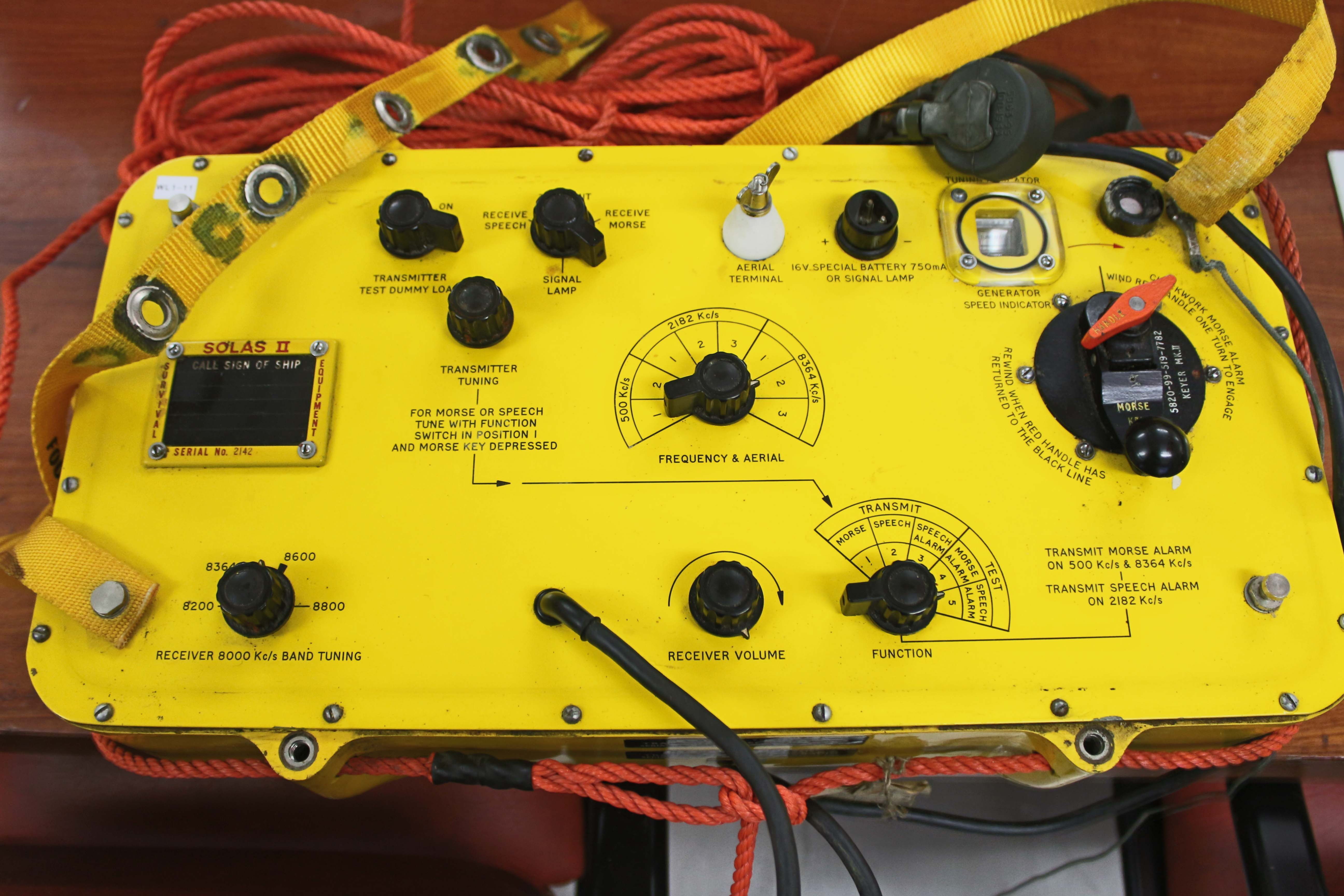 |
|
 |
An Eddystone 730/4 which to look at is identical to the QR and QS but with a different frequency range. The 730/4 covers 480kHz to 30MHz and was fitted in the SRE compartment of some ships in lieu of the 62B receiver which in itself looked exactly like the B40 but once again with a different frequency range. This Eddystone was saved from the scrap yard and with a bit of TLC is now fully working. |
|
A Callsign Encryption machine, officially known as SP02628 but more commonly referred to as a 'Fruit Machine'. |
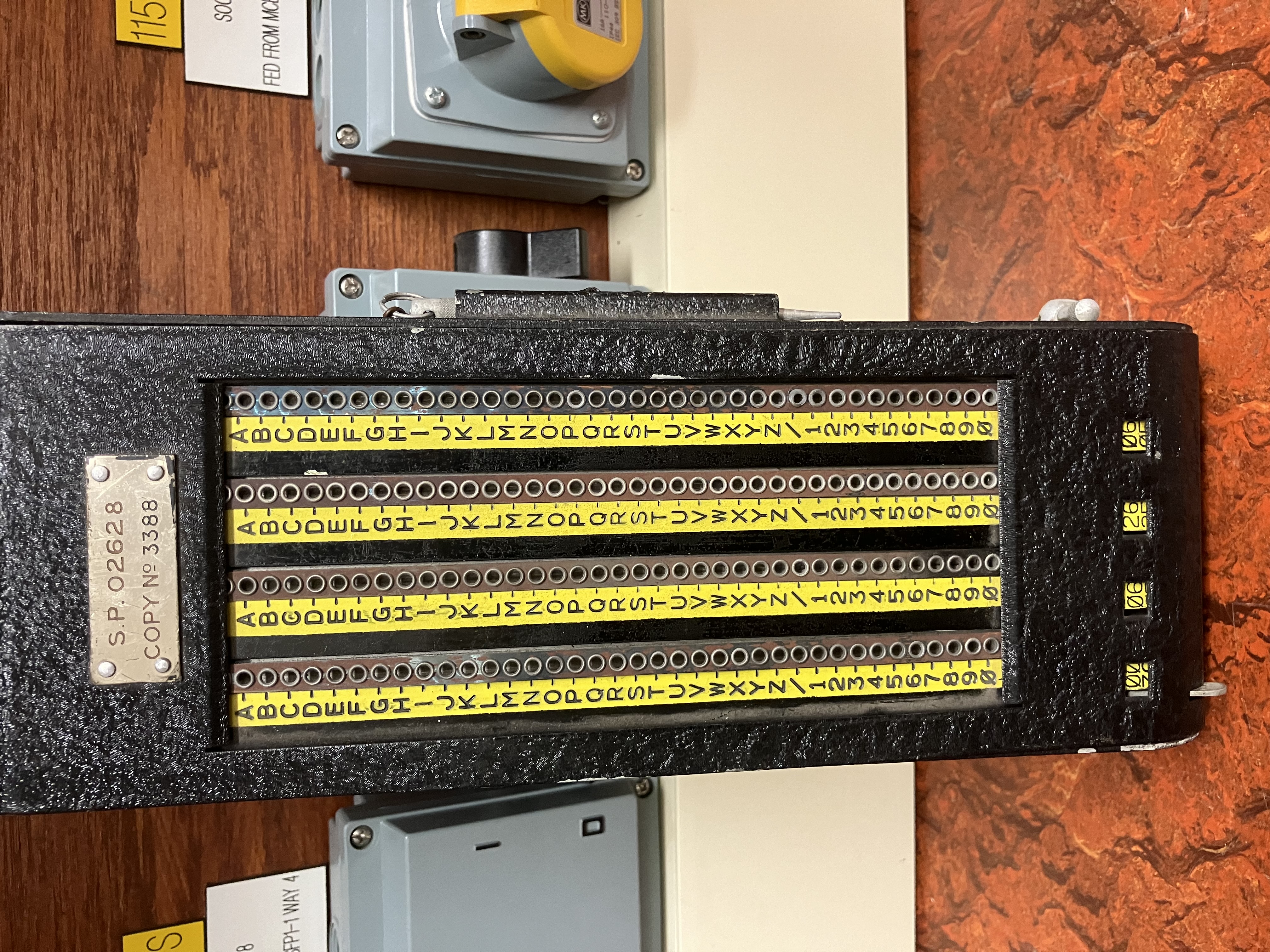 |
|
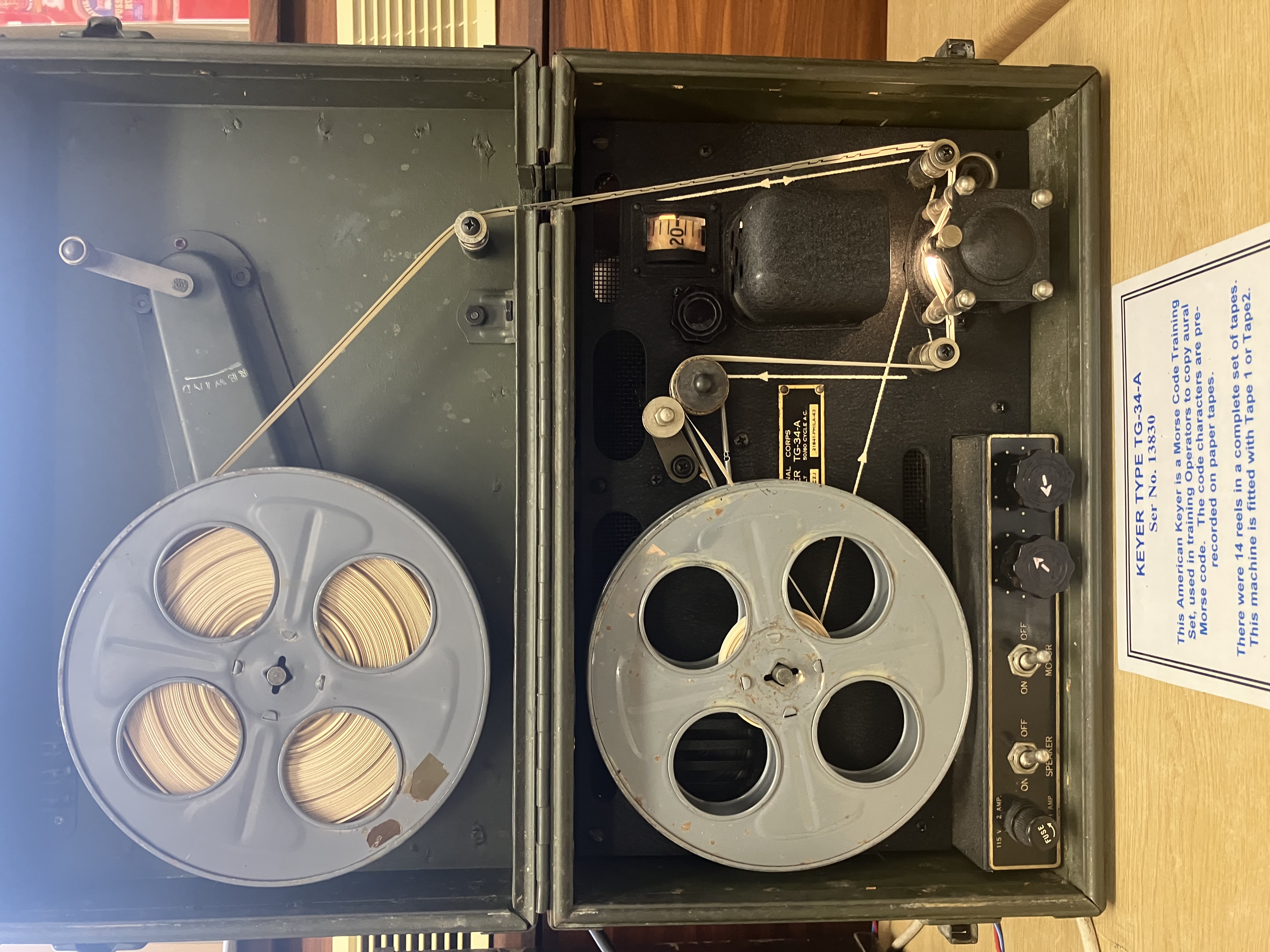 |
Keyer TG-34-A, is an automatic unit for reproducing audible code practice signals previously recorded in ink on paper tape (see Project Undulator). The unit is a component of Code Practice Equipment EE-94-C, EE-95-C, and EE-96-C. The unit can be used to provide code practice signals in permanent classrooms, for small groups in the field, or to provide a keying oscillator for use with a hand key. The unit is compact and portable, and reasonably weatherproof. It is self-contained, but requires an external a-c power source. Ventilation for tl\e cabinet is provided by a fan which is attached to the lower motor shaft. There were 14 reels of tape in a complete set. This machine is fitted with Tape 1 or Tape 2. |
|
|
|
Receiver Type R1471 Sec/Ref 10D/1465. This receiver was designed as a telegraphy diversity receiver and was used in conjunction with Output Unit Type 28, plus and Undulator to trace the received dots and dashes of high-speed Morse code signals onto a moving paper tape strip that was later read by an operator. This set is connected to the GNT 310 Undulator. |
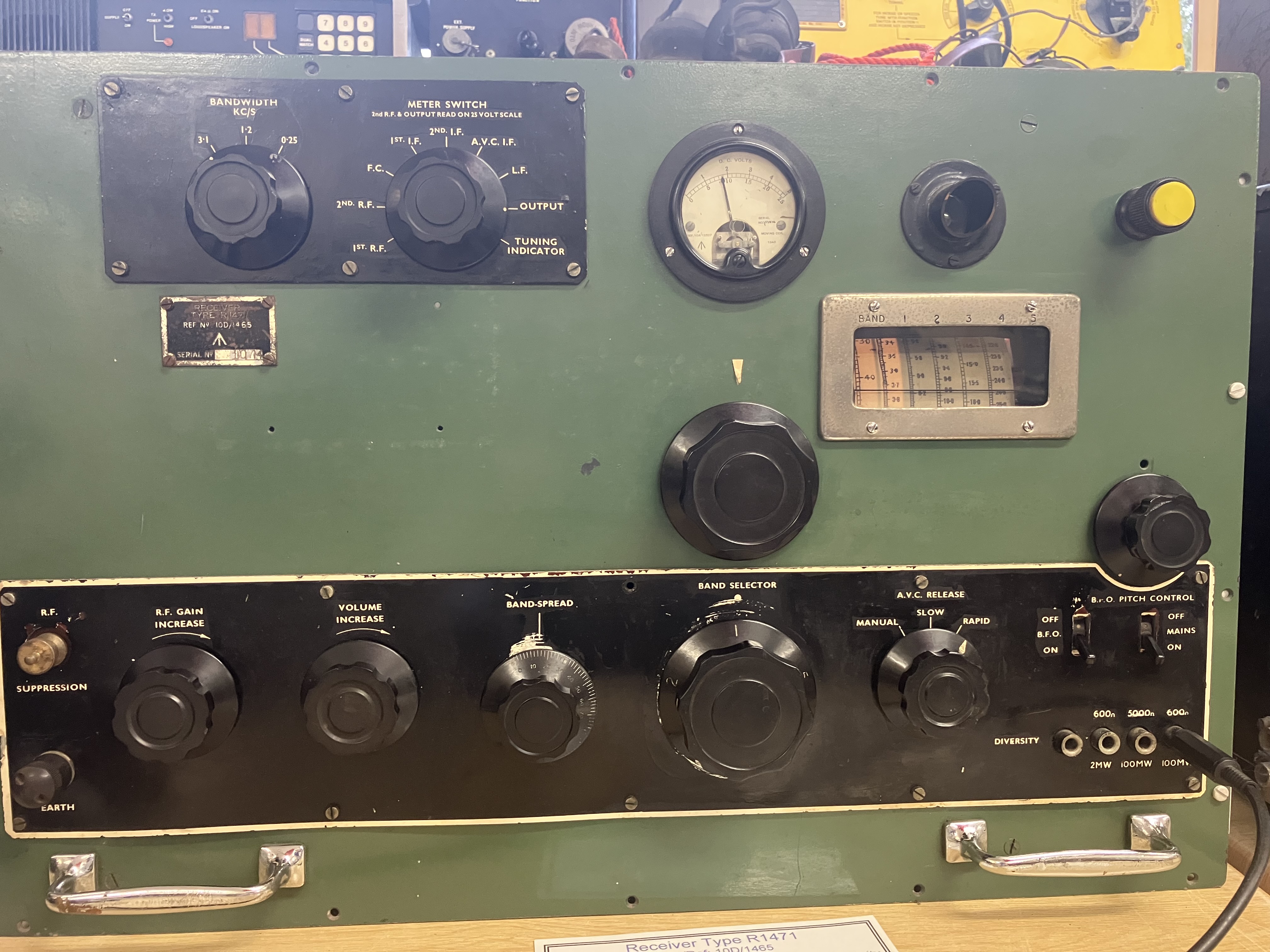 |
|
 |
NAVTEX is an international automated direct-printing service for promulgation of maritime safety information (MSI), navigational and meteorological warnings, meteorological forecasts and other urgent safety-related messages to ships. It was developed to provide a low-cost, simple and automated means of receiving MSI on board ships at sea in coastal waters. The information transmitted may be relevant to all sizes and types of vessels and the selective message-rejection feature ensures that mariners can receive MSI broadcasts which are tailored to their particular needs. |
|
|
Some short videos of some of the equipment in operation |
|
 |
This B40D was very kindly donated by Bill Morris. Bill's late father, Ken, had bought the B40D over 30 years ago. It is thought that it had sat in Ken's loft for over 30 years. Surprisingly it was still in very good condition - a quick hoover out and making several spiders homeless, the re-alignment of the turret frequency selector and some tweaking to the AF valves brought it back to life. |
|
The two pieces of equipment shown here are GNT 112 morse tape transmitters. The left hand one originally came from the HMS Mercury morse trainer circa 1950s and has a transmit speed range of 1 to 30wpm. The right hand machine is one of two that were rescued from the Corsham tunnels and is circa 1930s with a transmit speed range of 15 to 240wpm. The right hand machine was generally used to transmit morse code at around 100wpm to submarines where it was recorded onto tape and then slowed down to read it. These two machines were repaired using spares from the second machine recovered from Corsham. The middle piece of equipment is the Morse Trainer and the output from the GNT 112 (6v Mark 0v Space) has been connected to a relay switch to allow the output to be converted to audio morse. The GNT 112 is transmitting at approx 20wpm, although the speed has yet to be checked - this will be done once we have repaired the Creed Morse Tape Reperforator giving us the ability to produce a PARIS tape. Apologies for the poor sound quality of the morse code and the rumbling that can be heard is a bad bearing on the GNT 112 which will be replaced in due course. |
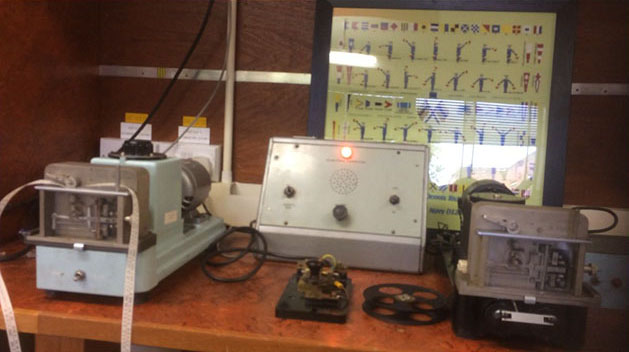 |
|
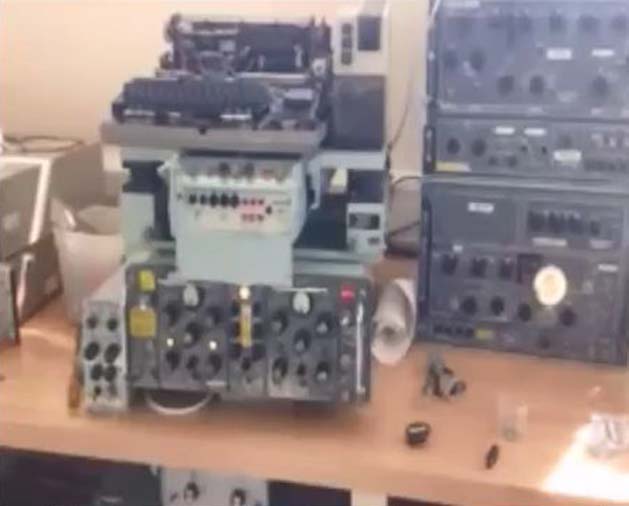 |
TTVF(B) under test using a CJP as the receiver. This TTVF(B) and a TGN Teleprinter were donated to Dave Clutten who looks after HMS Ocelots' (Chatham Dockyard) Communications Office. |
|
A CJP (donated by Kettering Sea Cadet Unit) brought back to life after many hours of work especially on the wiring loom. This set now sits in the museum providing the RATT input for the TTT and subsequent TGN. The RATT comes from DWD Hamburg which transmits a weather broadcast. The paramaters for reception are F1/170/1/50 with the audio being fed to a 'home made patch panel' to the TTT and onwards to the selected TGN. Two of the TGNs were donated by HMS Bristol and another 8 by Mick Rose, HMS Collingwood maintainer. All the TGNs were U/S (they had been used for maintainer training and had various faults applied to them) but with a great deal of help from Adrian Wright (Collingwood Historic Collection Museum) 8 of the TGNs were brought back to life. |
 |
|
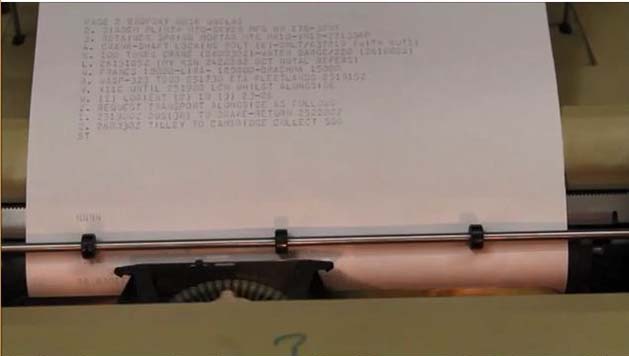 |
This video is a demonstration of a simulated B11A Broadcast. This was achieved with the use of a laptop computer which was programmed to convert text files into an audio output which was then fed to the TTT and onwards to the TGN. The background RATT audio is actually being provided by the CJP receiving the DWD Hamburg weather broadcast. |
|
This video is an example of Teleprinter Art. The picture of the Madonna and Child was created by enlarging a photograph of the original (thanks to Tom Stewart) and re-typing it. There is still a bit of work to be done on the shading before it looks perfect. We have several printed copies of various Teleprinter Art (Churchill, HM The Queen plus others) works and as time permits these will be converted to Teleprinter Art. |
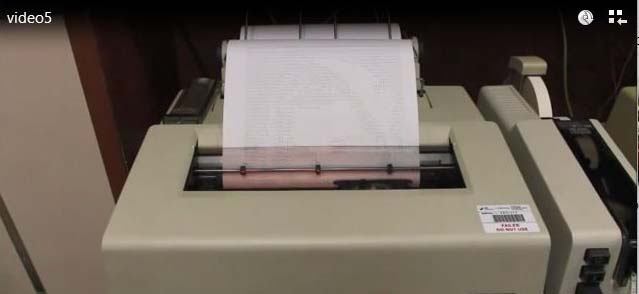 |
|
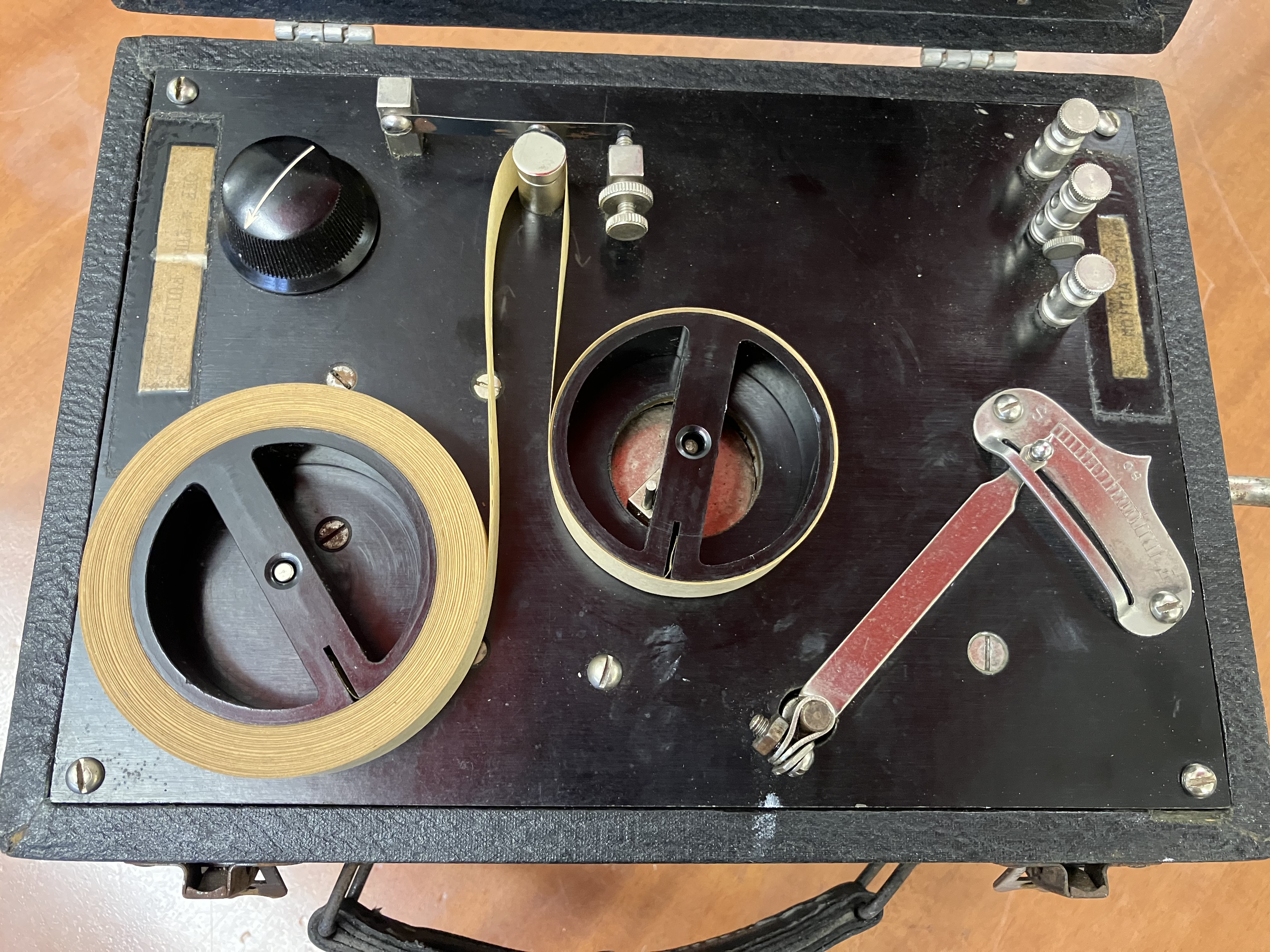 |
The Instructograph was a paper tape-based machine used for the study of Morse code. The paper tape mechanism consists of two reels which passed a paper tape across a reading device that actuated a set of contacts which changed state dependent on the presence or absence of hole punches in the tape. See The Instructograph |
